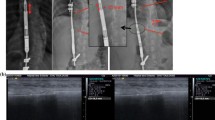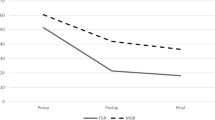Abstract
Purpose
Magnetically controlled growing rod systems have been introduced over recent years as an alternative to traditional growing rods for management of early onset scoliosis. The purpose of this paper is to report our early experience of a magnetically controlled growing rod system (MAGEC, Ellipse).
Methods
Review of pre-operative, postoperative and follow-up Cobb angles and spinal growth in case series of eight patients with a minimum 23 months’ follow-up (23–36 months).
Results
A total of six patients had dual rod constructs implanted and two patients received single-rod constructs. Four patients had MAGEC rods as a primary procedure. Four were revisions from other systems. Mean age at surgery in the primary group was 4.5 years (range 3.9–6.9). In patients who had MAGEC as a primary procedure, mean pre-operative Cobb angle was 74° (63–94), with postoperative Cobb angle of 42° (32–56) p ≤ 0.001 (43 % correction). Mean Cobb angle at follow-up was 42° (35–50). Spinal growth rate was 6 mm/year. One sustained proximal screw pull out. A final patient sustained a rod fracture. Mean age at surgery in the revision group was 10.9 years (range 9–12.6). Mean pre-operative Cobb angle was 45° (34–69). Postoperative Cobb angle was 42° (33–63) (2 % correction). Mean Cobb angle at follow-up was 44° (28–67). Mean spinal growth rate was 12 mm/year. Two patients developed loss of distraction.
Conclusion
MAGEC growing rod system effectively controls early onset scoliosis when used as either a primary or revision procedure. Although implant-related complications are not uncommon, the avoidance of multiple surgeries following implantation is beneficial compared with traditional growing rod systems.
Similar content being viewed by others
References
Akbarnia BA et al (2008) Dual growing rod technique followed for three to eleven years until final fusion: the effect of frequency of lengthening. Spine 33(9):984–990
Akbarnia BA et al (2005) Dual growing rod technique for the treatment of progressive early onset scoliosis: a multicenter study. Spine 30(17 Suppl):S46–S57
Akbarnia BA et al (2013) Next generation of growth-sparing techniques. Spine 38(8):665–670
Bess S et al (2010) Complications of growing-rod treatment for early onset scoliosis: analysis of one hundred and forty patients. J Bone Joint Surg Am 92(15):2533–2543
Caldas JC, Pais-Ribeiro JL, Carneiro SR (2004) General anaesthesia, surgery and hospitalization in children and their effects upon cognitive, academic, emotional and socio behavioural development—a review. Paediatr Anaesth 14:910–915
Cobb JR (1960) The problem of the primary curve. J Bone Joint Surg Am 42-A:1413–1425
Cheung K et al (2012) Magnetically controlled growing rods for severe spinal curvature in young children: a prospective case series. Lancet 379(9830):1967–1974
Dannawi Z (2013) Early results of a remotely-operated magnetic growth rod in early onset scoliosis. Bone Joint J 95-B(1):75–80
Dimeglio A, Canavese F (2011) The growing spine: how spinal deformities influence normal spine and thoracic cage growth. Eur Spine J 21(1):64–70
Kain ZN, Wang SM, Mayes LC, Caramico LA, Hofstadter MB (1999) Distress during the induction of anaesthesia and postoperative behavioural outcomes. Anesth Analg 88:1042–1047
Kain ZN, Mayes LC, O’Connor TZ, Cicchetti DV (1996) Preoperative anxiety in children. Predictors and outcomes. Arch Pediatr Adolesc Med 150:1238–1245
Noordeen HM, Shah SA, Elsebaie HB (2011) In vivo distraction force and length measurements of growing rods: Which factors influence on the ability to lengthen? Spine (Phila Pa 1976). doi:10.1097/BRS.0b013e31821b8e16
Smith JT, Campbell RM Jr (2012) Magnetically controlled growing rods for spinal deformity. Lancet 379(9830):1930–1931
Wick J, Konze J (2012) A magnetic approach to treating progressive early onset scoliosis. Assoc Regist Nurses 96(2):163–173
Yang JS et al (2011) Growing rod fractures. Spine 36(20):1639–1644
Conflict of interest
None of the authors has any potential conflict of interest.
Author information
Authors and Affiliations
Corresponding author
Rights and permissions
About this article
Cite this article
Hickey, B.A., Towriss, C., Baxter, G. et al. Early experience of MAGEC magnetic growing rods in the treatment of early onset scoliosis. Eur Spine J 23 (Suppl 1), 61–65 (2014). https://doi.org/10.1007/s00586-013-3163-0
Received:
Revised:
Accepted:
Published:
Issue Date:
DOI: https://doi.org/10.1007/s00586-013-3163-0




